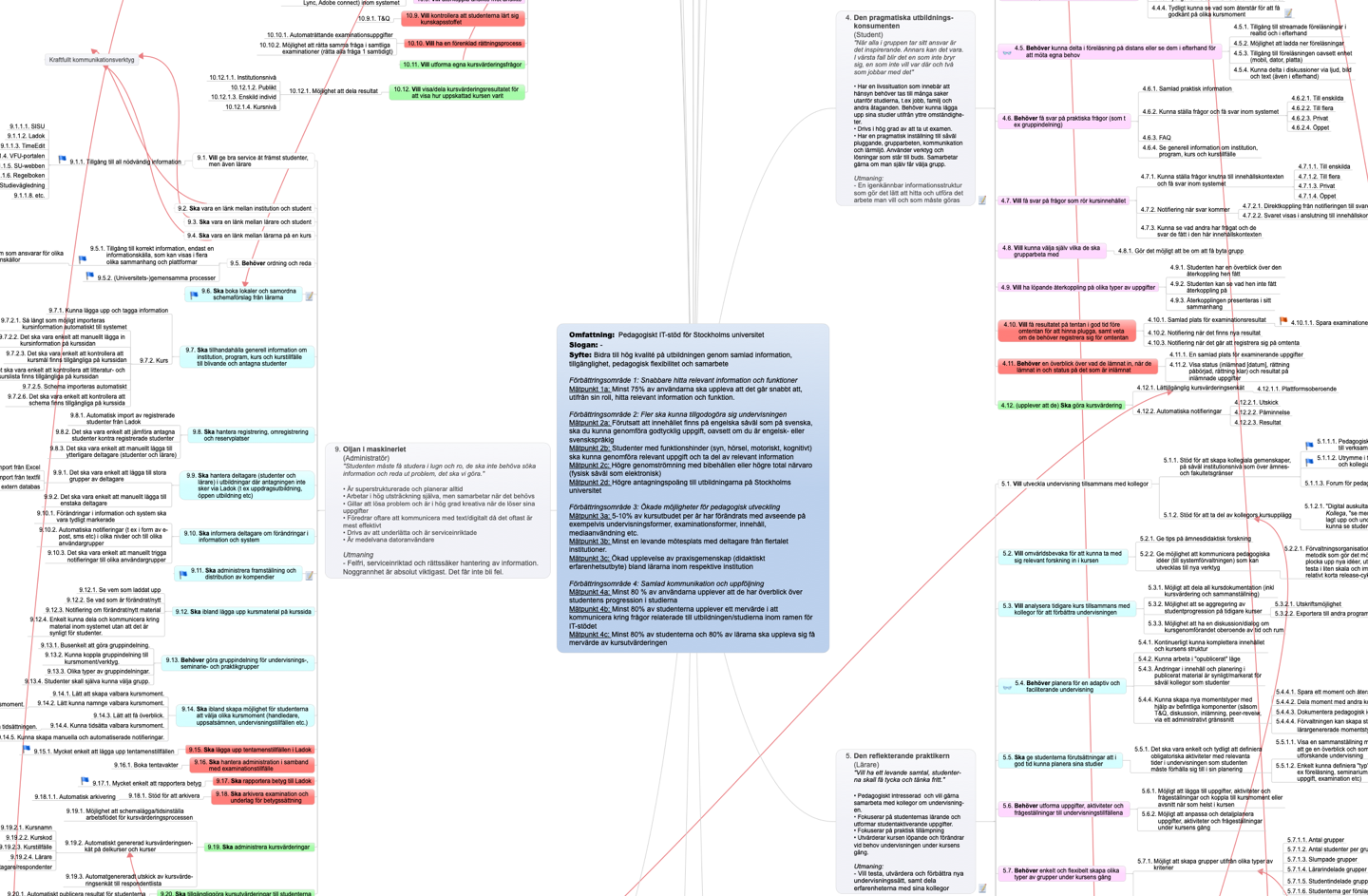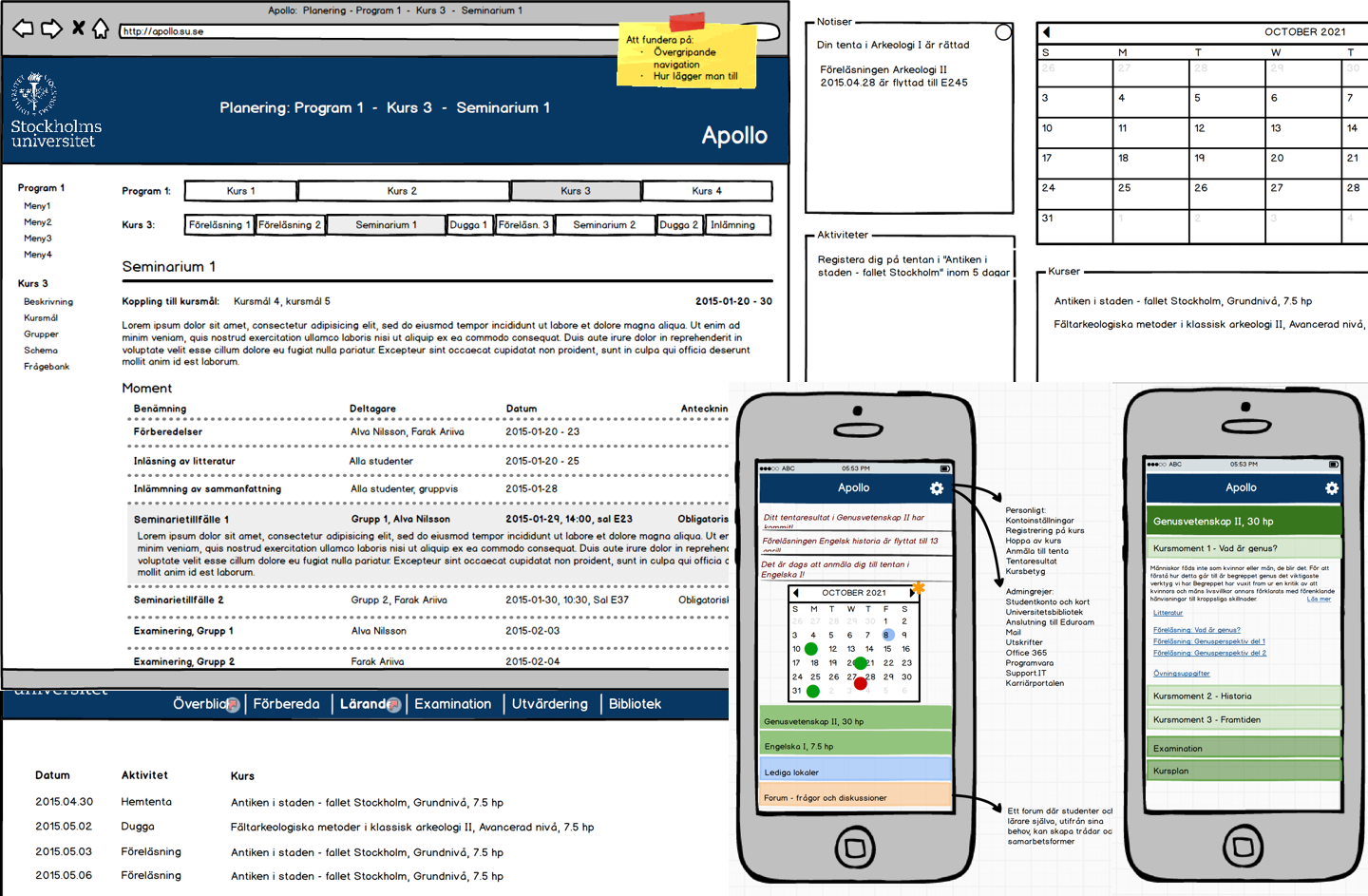Stockholm University - new Learning Management System

Background
About Stockholm University
Stockholm University offers a wide range of education in close interaction with research. Collaboration helps make Stockholm University’s expertise and results accessible and promotes quality in education and life-long learning. University Stockholm University has about 30.000 students, 1.400 doctoral students, and 5.700 members of staff.
The goal
The goal of the feasibility study was to deliver business and user-centered requirements and a proposal for adapted implementation for the new Learning Management System to replace the currently centrally offered learning and collaboration platform.
What I did
- In-depth interviews in a contextual inquiry
- Defining target groups with behavioral variables
- Business Impact Mapping
- Conceptual sketches
Problem

Interviews

The goal with the interviews
Understand and document:- the users' everyday life in the given context
- their needs and goals as well as the organization's
- how the users reach their goals - for example what tools they use
- how processes and collaborations work and in what ways they meet the goals of individuals and/or the organization
- what problems they have
- what works well
- Introduce and get the users onboard with the new LMS for good collaboration in the future.
How we did the interviews
We used a template with standard questions for the hypothetical target groups (students, teachers, administrators, librarians).Depending on what topics ware discussed we asked follow-up questions to get deeper to find the root cause for their needs.
Defining and prioritizing target groups

Behavioral variables
The hypothetical target groups ware assigned a list of behavioral variables. They are presented in sets of two opposites for example: Plans – Does not plan or Ambitious – Does the least possible. Every person that was interviewed was mapped on a scale between the behavioral variables.Forming the target groups
The next step was to look for clustering to look at trends – were several users had the same or close value on a behavioral variable. From that we looked for instances were several users had a number of trends in common – that formed the target groups. Some more general target groups were also identified to collect the needs that for example “All students” have in common.Describing the target groups
- A descriptive name
- A quote that summarizes their motives and behaviors
- Describe the most important things about them that have some impact on how they will value different designs
- Their challenges: what do we have to succeed with in order to make them happy with the new LMS?
Prioritizing target groups
In a workshop with reasonable stakeholders from the University management the decision was made with order the target groups should be prioritized. It was based on he groups that will give the greatest contribution to the business goals. Surprisingly this is often not the users the business is used to care about. In the end it was the general group “All teachers” that got the highest priority not a student target group that everybody assumed.Top target groups
- All users
- All teachers
- All students
- The pragmatic consumer of education (Student)
- The reflective practitioner (Teacher)
- The planning craftsman (Teacher)
Business impact mapping

Business impact
- Scope: What the impact map is about – a system for example
- Aim: ONE sentence that summarizes what the metrics are trying to express
- Impact area with impact metrics: Defines the Aim and describes different results in the business that we expect from using the system.
Target group
- An abstraction, usually not visual in real life
- Needs and behaviors that are recurring patterns in the audience
- Needs and activities that make measurable contribution to the expected Business Impact
Needs
The target groups needs that must imply a state where they are satisfied.A sentence that begins with:
- Want – close to hart
- Need – a job perspective
- Shall – we impose this upon them, they lack drivers. They are not so interested or even opposed to this
Capability
The capabilities that the system is expected to have in order to make users satisfied and create the expected Business impact.“Expected qualities”
Function
The functions that the system should (requirements) or could (suggestions) have that makes the qualities a reality.“What is to be built”

During several workshops business impact map was built with business impact, target groups, needs, capabilities and functions.
See the full business impact mapConceptual sketches

With the business impact map in place, the next step was to produce a number of concept sketches
that can be evaluated in how well they meet the requirements and the aim that the map expresses.

The sketches are at a fairly high level with a focus on relevant details and in different forms: Low-fi prototypes,
"Click-through" prototypes that, among other things, describe mapping between workflows and information architecture,
Interactive prototypes that illustrate and test the interactive behavior of a future system.

Common to all the sketches is that they are relatively quick and cheap to produce and evaluate.
This makes it possible to evaluate a number of different concepts.
Continuation

Proof of Concept
Next step was a “Proof of Concept” to test technical challenges
and solutions that have emerged in the work so far.
Ordering a new LMS
Later after I ended my employment at Stockholm University the work started with a new project
to buy a software that could be modified according to the requirements from this feasibility study.
Retrospective
What could be improved
- Better tools
- More efficient and streamlined process and administration
What went well
- The result was very usable requirements that can be used in many ways.
- We were a very professional, fun and dedicated team.